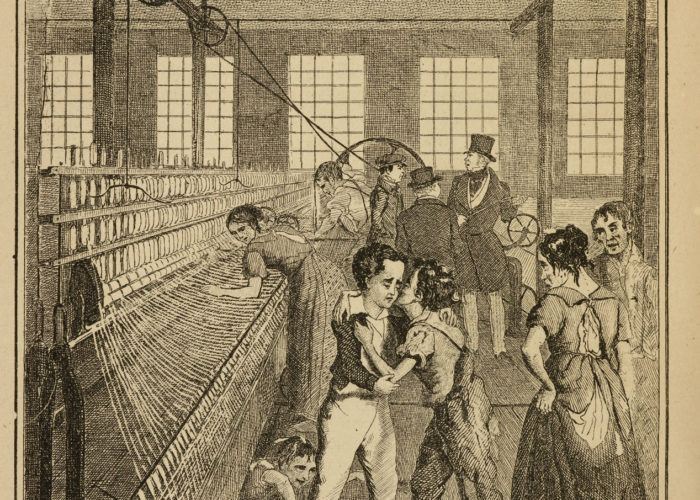The life and adventures of Michael Armstrong, the factory boy by Frances Trollope
Theme: The arts in the Age of Revolution, Challenging law and order: British riots and reforms, The impact of industry, Economic and technological revolution, Printing revolution, British politics in the Age of Revolution, People in motion: exiles and opportunities
This illustrated novel by Frances Trollope (1779-1863) was published in monthly parts in 1840, costing one shilling apiece. It tells a fictional story of Michael Armstrong, based on the real-life hardships, exploitation and suffering of children in the workplaces of the Industrial Revolution. It was the first novel about industrial life in Britain and made an important contribution to the campaign to reform conditions for workers – especially children.
The Industrial Revolution gathered pace through the 1800s, with new factories, transport and mines transforming both the landscape and people’s working lives. Young people from poor families were typically forced to work long hours (at least 12 hours each day), for very little pay in dusty and noisy mills and factories – often away from their families. And it wasn’t just mill owners who took advantage of children. They also worked in mines, up chimneys as chimney sweeps – or ‘climbing boys’ – and sold goods on the streets in all weathers. As children were small, nimble and underweight, they worked in and under heavy moving machinery and in limited spaces. There were frequent injuries, which were often fatal. Children’s lungs were damaged by dust, oil and soot.
Frances Trollope was drawn to the subject by existing memoirs, but researched her story first-hand. In the textile mills of Manchester she witnessed the noisy and dangerous conditions that children as young as 6 years old were working in. She talked to the workers and also people dedicated to the improvement of these conditions. In her preface to the book, Frances explained her mission to: “place before the eyes of Englishmen, the hideous mass of injustice and suffering to which thousands of infant labourers are subjected, who toil in our monstrous spinning-mills.”
Her story shocked readers and pioneered a new way for social reformers of the time to reach their audiences, and campaign for better conditions. Over the course of the 1800s these campaigns would lead to government acts, which slowly improved working conditions and protected the rights of children, beginning with the Factory Act of 1844 which limited children aged 8-13 to a six-and-a-half-hour shift.
Did you know..?
It wasn’t until 1880 that education was made compulsory for all children up to the age of 10. It was 1901 before the minimum working age for children was raised to 12 years old.
Use our Classroom resources to investigate this object and the Industrial Revolution and the Arts in the Ages of Revolution further.
Highlights:
- Using objects, artworks and other sources to find out about the past
- Introducing the Age of Revolution
- Using museum collections as creative starters
- How to make a revolutionary stop-frame animation
And much more…
Sources & acknowledgements
This object description and its related educational resources were researched and written by our team of historians and education specialists. For further information see the item’s home museum, gallery or archive, listed above.
- Enquiry Questions
-
Did you know..?
It wasn’t until 1880 that education was made compulsory for all children up to the age of 10. It was 1901 before the minimum working age for children was raised to 12 years old.
-
Education overview
You can access a range of teachers resources related to this object and more on our education page.
Please also see our glossary of terms for more detailed explanations of the terms used.
-
Curatorial info
- Originating Museum: British Library
- Accession Number: YA.1994.a.7128
- Production Date: 1876
- Creator: Frances Trollope, Auguste Hervieu [illustrator]
- Creation Place: Newcastle-Upon-Tyne
- Original record
-
Use this image
Image courtesy of the British Library.
You can download this image for personal and educational use but please take note of the license type and rights holder information.
- License Type:
Find it here
This object is in the collection of British Library



